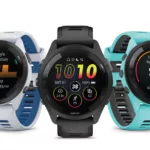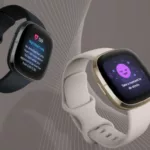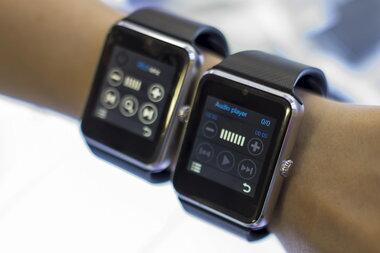Fitbit Charge 5 vs. Charge 4 – worthy upgrade?
Fitness trackers have become increasingly popular in recent years, with many people using them to track their daily activity levels, monitor their heart rate, and keep track of their sleep patterns. Fitbit is one of the most well-known brands in this category, and the Fitbit Charge series is one of their most popular product lines.
In this article, we’ll be comparing the Fitbit Charge 5 to the Fitbit Charge 4. Both of these fitness trackers offer a range of features designed to help you stay on top of your health and fitness goals. However, there are some key differences between the two that you’ll want to keep in mind when making a purchase.
One of the most critical factors to consider when choosing a fitness tracker is the range of features it offers. The Fitbit Charge 5 is the newer of the two models and comes with some additional features that the Charge 4 doesn’t have. For example, the Charge 5 includes an EDA sensor that can help you manage stress levels, as well as an ECG app that can detect irregular heart rhythms.
Another critical consideration when choosing a fitness tracker is the design and comfort level. Both the Charge 4 and Charge 5 have similar designs, with a slim and lightweight profile that makes them comfortable to wear all day. However, the Charge 5 has a slightly larger display screen, which may be a factor for some users.
Ultimately, the choice between the Fitbit Charge 5 and Charge 4 will depend on your specific needs and preferences. If you’re looking for a fitness tracker with the latest features and technology, the Charge 5 may be the right choice for you. However, if you’re happy with the features offered by the Charge 4 and prefer a slightly smaller display screen, that model may be the better option.
Fitbit Charge 5 vs. Charge 4: Which is the Best Fitness Tracker for You?
Are you looking for a reliable fitness tracker to help you achieve your fitness goals? Look no further than the Fitbit Charge 5 and Fitbit Charge 4. Both of these fitness trackers come packed with features that can help you track your progress, monitor your heart rate, and even improve your sleep quality.
In this article, we will provide you with a detailed comparison of the Fitbit Charge 5 and Fitbit Charge 4. We will explore the features of each device, their similarities, and differences. We will also provide you with insights on which device is best suited for your needs.
So, whether you’re an athlete looking to improve your performance, or a fitness enthusiast looking to stay on top of your health, read on to find out which Fitbit is the best fit for you.
Fitbit Charge 4 Fitness and Activity Tracker

If you’re looking for a fitness tracker that can help you track your workouts, sleep, and overall health, the Fitbit Charge 4 is a great option. With built-in GPS, heart rate monitoring, and a long battery life, this sleek and swim-proof tracker has everything you need to stay motivated and reach your fitness goals.
Pros
- Built-in GPS allows you to see your pace and distance on screen during outdoor workouts
- Active Zone Minutes feature helps you reach your target heart rate zones during exercise
- 90-day free trial of Fitbit Premium offers additional features to help you stay active, sleep well, and manage stress
Cons
- Inconsistent heart rate monitoring during exercise affects calorie count accuracy
- Syncing to mobile devices requires Bluetooth LE and internet connection
- Some steps may be missed due to the way the tracker is made
The Fitbit Charge 4 is a great fitness tracker for those who enjoy outdoor workouts. With built-in GPS, you can easily track your pace and distance during runs, hikes, and more. The Active Zone Minutes feature is also a great addition, as it helps you reach your target heart rate zones during exercise and celebrates when you earn extra minutes outside of exercise.
One downside of the Charge 4 is the inconsistent heart rate monitoring during exercise, which can affect the accuracy of calorie count. Additionally, syncing to mobile devices requires Bluetooth LE and internet connection, which may be a hassle for some users. Lastly, some steps may be missed due to the way the tracker is made.
Overall, the Fitbit Charge 4 is a great fitness tracker for those who want to stay motivated and track their progress. With a long battery life and additional features like Fitbit Premium, it’s a great investment for anyone looking to improve their overall health and wellness.
Fitbit Charge 5 Advanced Health & Fitness Tracker

Should you purchase the Fitbit Charge 5? Yes, if you’re looking for a comprehensive fitness tracker that helps you optimize your workouts, manage stress, and track your heart health.
Pros
- The Daily Readiness Score helps you determine whether you’re ready for exercise or should focus on recovery.
- The on-wrist EDA sensor and mindfulness sessions help you manage stress levels and improve your overall well-being.
- The built-in GPS and Active Zone Minutes feature make it easy to track your workouts and optimize your intensity level.
Cons
- The Fitbit ECG app is only available in select countries and not intended for use by people under 22 years old.
- The Health Metrics dashboard is not intended to diagnose or treat any medical condition and should not be relied on for any medical purposes.
- The interface can be a bit temperamental, making it difficult to wake up at times.
The Fitbit Charge 5 is an excellent fitness tracker that’s packed with features to help you optimize your workouts and improve your overall health. The Daily Readiness Score is a unique feature that helps you determine whether you’re ready for exercise or should focus on recovery. The on-wrist EDA sensor and mindfulness sessions are also great for managing stress levels and improving your overall well-being.
The built-in GPS and Active Zone Minutes feature make it easy to track your workouts and optimize your intensity level. The Health Metrics dashboard is also a handy tool for tracking your heart health, although it’s important to note that it’s not intended to diagnose or treat any medical condition and should not be relied on for any medical purposes.
One downside of the Fitbit Charge 5 is that the Fitbit ECG app is only available in select countries and not intended for use by people under 22 years old. The interface can also be a bit temperamental at times, making it difficult to wake up.
Overall, if you’re looking for a comprehensive fitness tracker that helps you optimize your workouts, manage stress, and track your heart health, the Fitbit Charge 5 is an excellent choice.
Fitbit Charge 5 vs. Fitbit Charge 4
Looking to upgrade your fitness tracker? Here’s what you need to know about the Fitbit Charge 5 and Fitbit Charge 4.
Pros
- Fitbit Charge 5: Sleek and stylish design, with a larger and brighter display.
- Fitbit Charge 4: More affordable option, with built-in GPS and Spotify controls.
- Both models offer 24/7 heart rate tracking and a range of fitness tracking features.
Cons
- Fitbit Charge 5: More expensive than the Charge 4, and lacks built-in GPS.
- Fitbit Charge 4: Smaller display and less modern design compared to the Charge 5.
When it comes to fitness tracking, both the Fitbit Charge 5 and Charge 4 offer a range of features to help you reach your goals. The Charge 5 boasts a sleek and stylish design, with a larger and brighter display than its predecessor. It also offers a range of health monitoring features, including stress management tools and skin temperature tracking.
On the other hand, the Charge 4 is a more affordable option that still offers built-in GPS and Spotify controls. It’s a great choice for those who want to track their workouts without breaking the bank. However, its smaller display and less modern design may not appeal to everyone.
Overall, the Fitbit Charge 5 is a great choice for those who want a premium fitness tracker with all the latest features. However, if you’re on a budget or don’t need all the bells and whistles, the Charge 4 is still a solid choice. Whichever model you choose, you’ll be able to track your fitness progress and stay motivated to reach your goals.
Check out the Fitbit Charge 5 and Fitbit Charge 4 on Amazon today.
Fitbit Charge 5 vs. Fitbit Charge 4
If you’re in the market for a fitness tracker, the Fitbit Charge 5 and Fitbit Charge 4 are two great options to consider. Both offer advanced fitness tracking features, but there are some key differences to keep in mind.
Pros
- Charge 5: Sleek new design with a larger, full-color AMOLED display
- Charge 5: Improved heart rate monitoring with a new EDA sensor for tracking stress levels
- Charge 5: Longer battery life of up to 7 days
- Charge 4: Lower price point than the Charge 5
- Charge 4: Built-in GPS for tracking outdoor workouts without needing to bring your phone
- Charge 4: NFC payments through Fitbit Pay
While the Charge 5 has some impressive new features, the Charge 4 still offers a lot of value at a lower price point. The built-in GPS is a major advantage for outdoor workouts, and the NFC payments through Fitbit Pay can be very convenient.
If you’re looking for the latest and greatest, the Charge 5 is definitely worth considering. The new design and improved heart rate monitoring are both great features. However, if you don’t need those extra features, the Charge 4 is still a solid choice.
Fitbit Inspire 3 Health & Fitness Tracker

Pros
- Tracks a variety of health metrics, including skin temperature and blood oxygen levels
- Offers personalized insights and guided programs through a Fitbit Premium membership
- Lightweight and comfortable to wear all day and night
Cons
- Requires a Fitbit Premium membership for some features
- Irregular rhythm notifications and SpO2 tracking are not available in all markets
- Some users have reported issues with connectivity and information accuracy
Overall, the Fitbit Inspire 3 is a great choice for anyone looking to track their health and fitness in a simple and convenient way. The variety of health metrics it tracks is impressive, and the personalized insights and guided programs available through Fitbit Premium can be very helpful. However, it’s important to keep in mind that some features require a Premium membership, and there have been some reported issues with connectivity and accuracy.
Fitbit Charge 5 vs. Fitbit Charge 4
If you’re looking for a fitness tracker that can help you keep track of your daily activity, sleep, and workouts, you might be considering the Fitbit Charge 5 or the Fitbit Charge 4. Both of these fitness trackers have a lot to offer, but each has its own strengths and weaknesses. Here are some pros and cons of each device:
Fitbit Charge 5
- Pro 1: The Charge 5 has a larger and brighter display than the Charge 4, making it easier to read your stats.
- Pro 2: The Charge 5 has a built-in GPS, so you can track your outdoor workouts without needing to bring your phone with you.
- Pro 3: The Charge 5 has a Daily Readiness Score that can help you determine whether you’re ready for a workout or need to take a rest day.
- Con 1: The Charge 5 is more expensive than the Charge 4.
- Con 2: The Charge 5 has a shorter battery life than the Charge 4.
- Con 3: The Charge 5 doesn’t have physical buttons, which some users may prefer over a touch screen.
The Fitbit Charge 5 is a great choice if you want a fitness tracker with a built-in GPS and a larger display. The Daily Readiness Score is also a useful feature if you’re looking to optimize your workouts.
Fitbit Charge 4
- Pro 1: The Charge 4 has a longer battery life than the Charge 5, lasting up to 7 days on a single charge.
- Pro 2: The Charge 4 has physical buttons, which some users may prefer over a touch screen.
- Pro 3: The Charge 4 is less expensive than the Charge 5.
- Con 1: The Charge 4 doesn’t have a built-in GPS, so you’ll need to bring your phone with you to track outdoor workouts.
- Con 2: The Charge 4 has a smaller and dimmer display than the Charge 5.
- Con 3: The Charge 4 doesn’t have the Daily Readiness Score feature.
The Fitbit Charge 4 is a great choice if you want a more affordable fitness tracker with a longer battery life. The physical buttons may also be a selling point for some users.
In conclusion, both the Fitbit Charge 5 and the Fitbit Charge 4 have their own strengths and weaknesses. Consider your priorities and budget before making a decision on which one to purchase.
Buying Guide
When choosing between the Fitbit Charge 5 and Fitbit Charge 4, there are several factors to consider. Here are some key features to look at when making your decision.
Design and Display
The design and display of the Fitbit Charge 5 and 4 are both sleek and modern. However, the Charge 5 has a larger and brighter AMOLED display, while the Charge 4 has a smaller and dimmer grayscale OLED display. Consider which display size and brightness level is best suited for your needs.
Fitness Features
Both the Fitbit Charge 5 and 4 offer a range of fitness tracking features, including heart rate monitoring, sleep tracking, and workout tracking. However, the Charge 5 has some additional features, such as an EDA sensor for stress management and an ECG app for heart health monitoring. If these features are important to you, the Charge 5 may be the better option.
Battery Life
The battery life of the Fitbit Charge 5 and 4 is similar, with both models offering up to seven days of use on a single charge. However, the Charge 5 has a faster charging time, with a full charge taking just 40 minutes compared to the Charge 4’s two-hour charging time.
Price
The Fitbit Charge 5 is more expensive than the Charge 4, so consider your budget when making your decision. If you’re looking for a more affordable option, the Charge 4 may be the way to go.
Compatibility
Both the Fitbit Charge 5 and 4 are compatible with iOS and Android devices, but the Charge 5 also offers compatibility with Google Assistant and Amazon Alexa. If you use these voice assistants frequently, the Charge 5 may be the better option.
In summary, when choosing between the Fitbit Charge 5 and 4, consider the design and display, fitness features, battery life, price, and compatibility. Determine which features are most important to you and select the model that best meets your needs.



